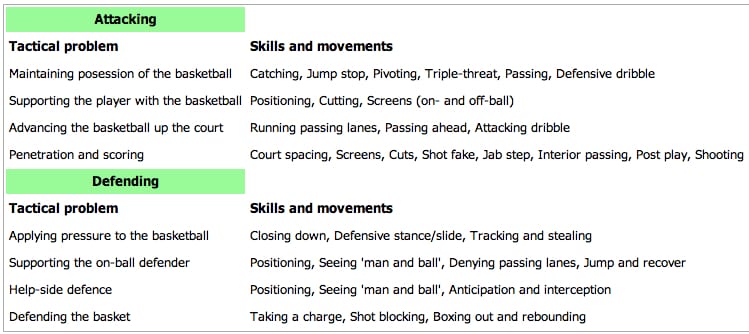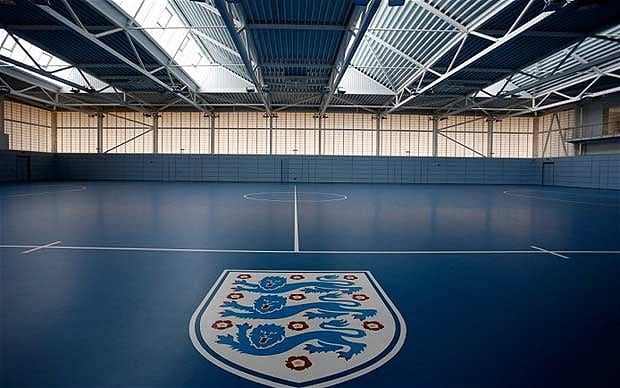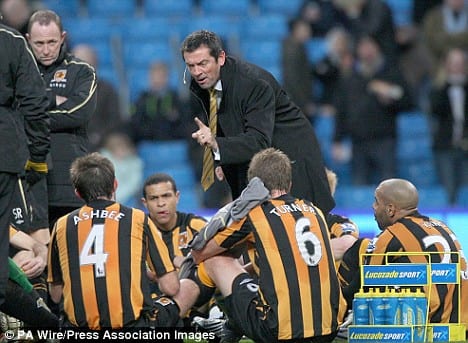Some weeks ago I was asked by the FA to deliver a CPD session to the FA Tesco Skills coaches at their national training event at St George’s Park. The session went ahead earlier this week and I thought I’d try to capture my thoughts on the matter here so they don’t escape from my head…
The session was all about how to teach decision making in invasion games, specifically basketball (and how it is similar to football). I was aware that the audience were mainly working with 5-11-year-olds, an age where decision-making is rarely the focus of coaching sessions. However, I also knew that the coaches were highly educated and qualified and knew about different teaching models and the use of questions.
I separated my session into three main parts which I’ll address below in turn. The presentation from the session can be viewed here.
1. The tactical structure of invasion games
We began with a discussion of the similarities and differences between basketball and football. Both sports are invasion games, of course, and therefore share deep tactical similarities in terms of the problems they pose to players. The following tables, derived from the wikicoach website, illustrate this point well.


It is clear that the two sports share common tactical problems and also some skills and movements, particularly in defending. However, we also discussed and noted some key differences that should act as warnings for coaches who want to encourage positive transfer. Foremost among these differences are:
- The number of players and the size of the playing area;
- The use of hands (and therefore control over the ball);
- The speed at which teams are forced to attack.
A basketball team has five players, all of whom attack and defend in a relatively small space. A team must shoot within 24 seconds of gaining possession and may only take 8 seconds to get the ball over the half-way line, over which they are not allowed back. All of these rules make basketball a much faster and more immediate sport, where players are under constant pressure when in possession of the ball (due to the space and time constraints). In this respect, playing basketball may help condition football players to be more comfortable with the ball when under pressure; to make fast decisions at both ends of the floor; and help condition footballers in defensive movement, as the ball can be moved much faster in basketball. It was with this possible positive transfer in mind, then, that I approached the FA Skills coaches with a problem that I believe to be pivotal in teaching both games.
2. The problem: how do we reduce the options (and therefore decisions) that invasions games pose to players?
When presented with a game of basketball or football, young players (or beginners) often struggle to make decisions due to the dizzying array of stimuli and options the games present. In any given second, you may need to pay attention to three or four players (often moving quickly), the ball, the goal and your own position relative to these stimuli. The aim of both games is to score more goals or points than the opposition, and scoring often requires the coordinated actions and movements of a number of players over a short period of time. This is clearly very difficult to do, especially when faced with an opposition team who are doing everything in their power to stop you. This problem of learning how to create clear-cut scoring opportunities via coordinated movement and effective decision-making is one to which basketball coaches have generated various solutions. A critical discussion of these solutions formed the basis of the middle of my session.
In short, and looking only at offensive aspects of the game, basketball could be said to have developed three different kinds of solution:
- Streetball: this is effectively a flat out rejection of the possibility of systematising offensive movement. Streetballers play games with few rules and limited numbers (often 2v2 or 3v3) and rely on instinct and individual creativity for scoring. Many children are first exposed to basketball in this way and the game undoubtedly encourages and engenders experimentation and playfulness. However, making the transition into organised 5v5 basketball can be a problem for streetballers. Coping with the larger spaces and increased numbers of players places high demands on decision-making.
- Sets: possibly the most common solution to the problem is for the coach to take decision-making out of the players’ hands altogether. Set plays are possible and popular in basketball due to the factors noted above (ball in hands, fewer players, time constraints). However, set plays are predictable and players who develop in such systems do not learn how to make decisions in dynamic circumstances. Developmentally, teaching offensive principles and skills through set plays is counter productive.
- Principles: in response to the predictability of sets, some coaches have developed offensive systems based on principles rather than rules. One recent example is “Read & React” (R&R): a system developed by Rick Torbett under his Better Basketball brand. R&R is marketed as a complete system for developing ‘thinking players’ and also running a team offense. Like similar systems that have come before it (e.g. motion, triangle, Princeton), R&R has a more flexible set of principles players are taught to follow. In this case, it’s all about reading the ball-handler and making a series of reactions based on their movement. For example, if the on-ball player dribbles to the hoop the rest of the team circle away from the ball; if the player dribbles at a teammate, they can choose to set a screen or cut to the basket. The video below contains a more detailed explanation.
Now, I’m sure all these distinguished coaches weren’t paid a penny to endorse R&R. I’m confident that they all really think it’s “groundbreaking”. Yet although R&R is certainly better than traditional Xs and Os, all it really offers is a slightly expanded set of decisions that the coach makes on the players’ behalf. I like to notion of teaching players to read their teammates and to practice varied responses, but this still falls short of teaching decision making. Rather, R&R teaches players to choose among a small number of coach-defined responses in response to artificially simplified stimuli. In short, to the question: how do we reduce the options that invasions games pose to players?, the R&R response is: the coach artificially simplifies the stimuli and possible responses and then drills the reactions until they become habit. This, to me, in unsatisfactory and I explained to the FA Skills coaches that I though there was another way.
3. The TGfU solution and teaching zone defending in basketball
The only other solution to this problem I’m aware of that has some validity is offered under the name of Teaching Games for Understanding (TGfU). Since most of the coaches in the workshop were aware of TGfU, I didn’t need to offer much by way of introduction (I’ve already given my own interpretation of TGfU in this blog). I simply explained my own view of how TGfU could assist with teaching decision making. The three core ideas I went on to illustrate in my practical session were as follows:
- Modified/simplified games help us to limit stimuli and simplify decision-making in environments that still resemble the ‘real thing’.
- Open questions help us to focus learners’ attention on the tactical problems that games present (e.g. how to apply pressure to the ball?)
- Mistakes are inevitable and natural and must be seen as learning opportunities by both coach and player.
The first point here is crucial. Where R&R sees the coach artificially limit options (and decisions), TGfU allows the simplified game to do this instead. The coach’s role, therefore, is to gradually alter the conditions of the game to slowly increase options, making decision-making progressively more difficult. Games are also modified to remove barriers to success (e.g. allowing players to catch rather than dig a downward hit in a 3v3 volleyball game). Taking these ideas on board, I delivered a short session on zonal defending on the futsal court with a group of 10 players (I chose a defensive session since I believe this is where the two sports share the most similarities, both in tactics and movement).
[The activity ideas were inspired by Dennis Slade’s book, Transforming Play, whilst the ideas for structuring the session came from Lynn Kidman’s Developing Decision Makers and Mitchell, Griffin and Oslin’s Teaching Sports Concepts and Skills]
Session aim:
To help players explore the transferable problems of ‘applying pressure to the ball’ and ‘supporting the on-ball defender’.
Session plan:
| Component | Time | Description | Questions (possible answers) |
| Warm-up: Hi-Lo-D | 15 mins | The purpose of the warm up was to gradually increase the number of stimuli players had to attend to; to have them switch between focussing on specific and general stimuli; and to practice some basic defensive skills and movements. In short, the warm-up was specific to a defensive decision-making session. | N/A |
| Game 1: Four corners | 15 mins | I split the group into two teams of 5, with 3 players on court for each team (the remain players acted as coaches and could call timeouts). I set out channels of 2m width on each sideline and placed 4 hoops in the corners of the court (half a futsal court) each with a large flexi-cone in the middle. These were the goals. We began play with a basketball. The aim of the game was to score by hitting the cones in the opponent’s half with the ball. Initially, players were not allowed to dribble with the ball (i.e. netball movement was enforced). | What sort of shape is best for defending the goals? (triangle: one on ball, one on goal, one covering) |
| Game 2: Transition | 15 mins | Once the teams had had chance to discuss defensive tactics and practice the triangle zone, I introduced new conditions: 1) the coaches now become active and play in either channel, receiving an outlet pass after a turnover if possible; 2) if a goal is score after an outlet pass, the goal is worth double points; 3) players are allowed to make a one-bounce dribble (this helps speed up transition play and helps to move the defence). | How can you prevent a fast break? (pressure the ball early and prevent the outlet pass) |
| Game 3: Overload | 10 mins | The final progression meant that players in the channel could join the attack after passing into a teammate, creating a temporary 4v3. I also allowed players in the channels to challenge one another (they had been uncontested previously). Again, double points were awarded for a transition goal. In this final game we looked at how the defensive team responds to an overload situation. In particular, it is very easy for the offensive team to switch the play to score here, so the defensive team had to find a way to counteract the switch (e.g. slide quickly or rotate roles). Teams were encouraged to experiment with both strategies. | How does the zone defence more as the ball moves? (slides as the ball switches; rotation may be necessary to maintain ball pressure) |
In conclusion, I tried to explain that the purpose of the session was to demonstrate how modified games can help reduce options and possible decisions in invasion games. Thereafter, by altering conditions to gradually increase the options available to players (thereby progressively increasing the complexity of decision-making), coupled with tactical questions, coaches can facilitate the development of effective decision-makers in both basketball and football.

